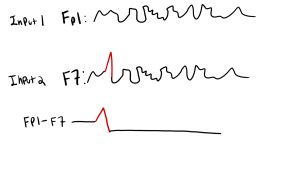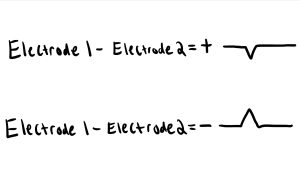Polarity Rules & Localization
Kobe Christensen and Jim Hutchins
POLARITY RULES & LOCALIZATION
Introduction
At the basis of an EEG is the differential amplifier. The differential amplifier will take the waveform at a single electrode and compare it to the waveform at another electrode to give a single waveform. For example, in the channel Fp1-F7 only a single waveform is displayed on the screen. This is because the differential amplifier has taken the data from the singular Fp1 electrode, and compared it to the data of the singular F7 electrode, and “Combined” those two waveforms together to give you the single waveform in the Fp1-F7 channel. This is visually represented below

The method that the differential amplifier uses to “Combine” the waveforms is called common mode rejection. Common mode rejection essentially means that the amplifier takes the two individual waveforms and subtracts them from one another. This means that everything the individual waveforms have in common will be filtered out when they are combined. This is depicted in the image above, with the individual waveforms being identical except for the red spike. The differential amplifier will use common mode rejection to subtract the parts that are the same, leaving ONLY the red spike in the combined waveform.
Polarity Rules
The differential amplifier mentioned above works by taking two electrodes, and subtracting the voltages from each electrode to give a single waveform. This can be represented by (Voltage of Electrode 1 – Voltage of Electrode 2 = Combined Waveform). What must be understood, and is absolutely essential to answering polarity questions is understanding that if the combined waveform voltage is Positive there will be a downward deflection on EEG, if the combined waveform voltage is Negative there will be un upward deflection on the EEG. This is represented visually by the image below

The following video goes over practice problems with polarity rules that you are likely to see on test day, and gives the tools to determine whether or not a waveform will be positive or negative, and if it will have an upward or downward deflection.
Video
Localization
The concept of localization is using the polarity rules above to take discharges seen on EEG and trace them back to the location that they came from on the scalp. The following video will explain how to use polarity rules to localize discharges, and go over some practice problems.
Video
Key Takeaways
- A differential amplifier uses common mode rejection to combine two waveforms into one.
- A positive combined voltage will have a downward deflection, a negative combined voltage will have an upward deflection.
- Phase reversals are important for localizing discharges. In a negative phase reversal, the the waveforms will point towards each other. In a positive phase reversal the waveforms will point away from each other.
H5P

